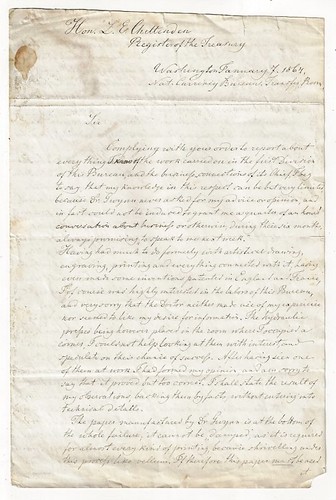
PREV ARTICLE
NEXT ARTICLE
FULL ISSUE
PREV FULL ISSUE
V25 2022 INDEX E-SYLUM ARCHIVE THE STUART GWYNN BANKNOTE PAPER DISASTERPatrick Parkinson passed along this Online Book and Ephemera Fair item relating to U.S. currency. Thanks - great item. -Editor Washington, DC, 1864 Autograph letter, signed, from O. Corvin to L.E. Chittenden, January 7, 1864. 3.5 pages in a neat hand on legal-sized lined paper, approximately 1,200 words in all. Folding creases, light soiling, a few short tears; very good.
His letter responds to a request from Chittenden for "a report about everything I know of the work carried on in the First Division of this Bureau." He expresses regret that he does not know as much as he would like, as Dr. Gwynn (Stuart Gwynn, a contractor hired by the Treasury Department to furnish special counterfeit-resistant paper and new presses for printing currency) has refused to consult or speak with him, despite his own considerable experience with "artistical drawing, engraving, printing, and everything connected with it." But he has been able to observe the goings-on in the Division, and reports that Gwynn's methods have essentially led to a disaster: The paper manufactured by Dr. Gwynn is at the bottom of the whole failure; it cannot be damped, as it is required for almost any kind of printing, because [it is] shriveling under this process like vellum. If, therefore, this paper must be used it can only be done by printing it dry. This cannot be done with the common roller press, for its texture is so very hard that it does not take the ink, which sticks only to its surface if made very stiff and subjected to the enormous pressure of a hydraulic press. The test proved satisfactory; but the paper was printed only on one side. When the back of the notes were printed afterwards, the immense pressure required to produce a print flattened the lines of the face print and spoiled it. The paper of the Doctor is therefore worthless for notes printed either on hydraulic or other presses. If this is not bad enough, Corwin reports that although "it was expected that these hydraulic presses worked by steam would surpass the roller presses at least in speed," in fact "three minutes and 50 seconds were required for one print on one side, the printing on both sides therefore requiring seven minutes forty seconds, or about eighteen seconds for each single note of 25 on each plate. To print one million dollars in five cent notes on one of these hydraulic presses would require about eleven years," as opposed to less than two years for a roller press. Yet the government has purchased 88 hydraulic presses at "the enormous price" of $1,700 each, (compared to $120 for a roller press), and many of them have broken down, resulting in further costs related to "delay, stopping of work, repairing of pumps and engines, etc." According to Corvin, anyone with printing knowledge should have been able to tell from the start that "the Doctor's papers, and the hydraulic presses made necessary by it, were a dead failure." In fact, the presses have become a standing joke around the office, such that anyone wanting "to give the characteristics of an ineffective thing or humbug...called it hydraulic." It has been difficult "to keep the disgusted printers quiet and induce them to continue their work," but "the reason no person employed in this Division made known this state of things to higher authorities is simply that people expressing themselves too freely about the Doctor's presses, paper, or person were promptly dismissed." Corwin concludes by explaining that as he was "anxious for the honor and interest of the Department," he had a quiet, confidential word with a personal friend of Treasury Secretary Salmon P. Chase, after which Chase's secretary, H.G. Plants, has paid him a visit and toured the printing facility. The report offered here was presumably the next step in an investigation which within a few months would lead to a Congressional investigation into fraudulent activities within the Treasury Department, and ultimately the arrest of Stuart Gwynn and a loss of faith in Spencer M. Clark, who had contracted with and supported Gwynn. (Clark would go on to further disgrace himself by putting his own face on currency that was reportedly supposed to bear the portrait of explorer William Clark). Several of the specific allegations included in Corvin's report appear in Col. L.C. Baker's official report on the matter, submitted to Congress in June, 1864.
To read the complete item description, see:
To read an earlier E-Sylum article, see:
Wayne Homren, Editor The Numismatic Bibliomania Society is a non-profit organization promoting numismatic literature. See our web site at coinbooks.org. To submit items for publication in The E-Sylum, write to the Editor at this address: whomren@gmail.com To subscribe go to: https://my.binhost.com/lists/listinfo/esylum All Rights Reserved. NBS Home Page Contact the NBS webmaster 
|

